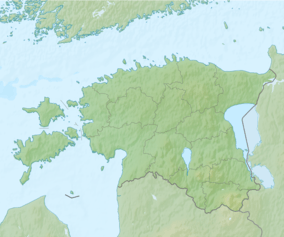Kohtla-Järve Power Plant
| Kohtla-Järve Power Plant | |
|---|---|
 Location of Kohtla-Järve Power Plant in Estonia | |
| Official name | Kohtla-Järve soojuselektrijaam |
| Country | Estonia |
| Location | Kohtla-Järve |
| Coordinates | 59°23′45″N 27°14′31″E / 59.395833°N 27.241944°ECoordinates: 59°23′45″N 27°14′31″E / 59.395833°N 27.241944°E |
| Status | Operational |
| Commission date | 1948 |
| Operator(s) | VKG Soojus |
| Thermal power station | |
| Primary fuel | Oil shale |
| Secondary fuel | Oil shale gas |
| Tertiary fuel | Shale oil |
| Cogeneration? | yes |
| Power generation | |
| Make and model | Sverdlovsk Turbine Works |
| Thermal capacity | 534 MW |
| Nameplate capacity | 39 MW |
The Kohtla-Järve Power Plant (Estonian: Kohtla-Järve soojuselektrijaam) is an oil shale-fired power plant in Kohtla-Järve, Estonia. It is owned by VKG Soojus, a subsidiary of Viru Keemia Grupp.
The Kohtla-Järve Power Plant was commissioned in 1949–1967 with designed electrical capacity 48 MW.[1] The first generator of the plant was commissioned in January 1949. This was the first time when the oil shale pulverized-firing combustion technology was implemented for power generation.[2] The first generator had a capacity of 12 MW.[3] At the beginning the plant used Riley Stoker boilers and General Electric generators; however, boilers developed for the pulverized firing of coal and lignite were not fit to work on pulverized oil shale.[3][4]
As of 2005, the power plant had capacity of 39 MW electricity and 534 MW of heat.[5][6] It is equipped by five stream generators and two hot water boilers (Barnaul BKZ-75-39F middle-pressure boilers. Its four turbines are manufactured by Fraser and Chalmers, Kirov Plant, Lang-Ganz, and Bryansk Turbine Works.[7]
In addition, an oil shale gas-fired plant was built next to existing plant. This plant is equipped with Energomash manufactured boilers and Kaluga Turbine Works manufactured turbines.[8]
References
- ↑ Ots, Arvo (2006) [2004]. Toni Tyson; Mary McQuillen, ed. Oil Shale Fuel Combustion. Tallinn: Arv Ots; Eesti Energia. pp. 13–17. ISBN 978-9949-13-710-7.
- ↑ Martins, A. (2012). "Historical overview of using fluidized-bed technology for oil shale combustion in Estonia." (PDF). Oil Shale. A Scientific-Technical Journal. Estonian Academy Publishers. 29 (1): 85–99. doi:10.3176/oil.2012.1.08. ISSN 0208-189X. Retrieved 2012-10-28.
- 1 2 Holmberg, Rurik (2008). Survival of the Unfit. Path Dependence and the Estonian Oil Shale Industry (PDF). Linköping Studies in Arts and Science. 427. Linköping University. p. 172. Retrieved 2012-10-27.
- ↑ Tallermo, Harri (2002). "Ilmar Öpik and oil-shale-fired boilers" (PDF). Oil Shale. A Scientific-Technical Journal. Estonian Academy Publishers. 19 (2 Special): 249–255. ISSN 0208-189X. Retrieved 2012-10-27.
- ↑ Gavrilova, Olga; Randla, Tiina; Vallner, Leo; Starndberg, Marek; Vilu, Raivo (2005). Life Cycle Analysis of the Estonian Oil Shale Industry (PDF) (Report). Tallinn: Tallinn University of Technology. p. 34. Retrieved 2012-10-27.
- ↑ Francu, Juraj; Harvie, Barbra; Laenen, Ben; Siirde, Andres; Veiderma, Mihkel (May 2007). "A study on the EU oil shale industry viewed in the light of the Estonian experience. A report by EASAC to the Committee on Industry, Research and Energy of the European Parliament" (PDF). European Academies Science Advisory Council: 24. Retrieved 2012-10-28.
- ↑ Siirde, Andres (2005). Reference values of efficient cogeneration and potential of efficient cogeneration in Estonia (PDF) (Report). Tallinn: Tallinn University of Technology. p. 28. Retrieved 2012-10-27.
- ↑ "Power Machines shipped equipment for Viru Keemia Grupp" (Press release). Power Machines. 2008-09-26. Retrieved 2012-10-28.